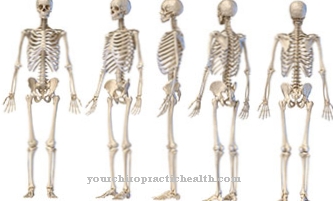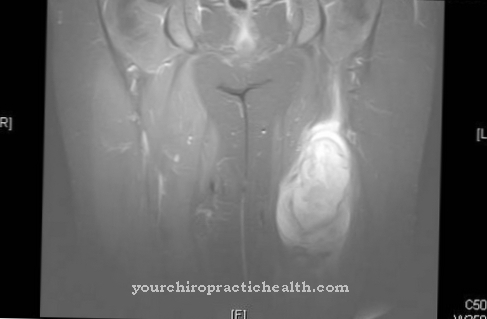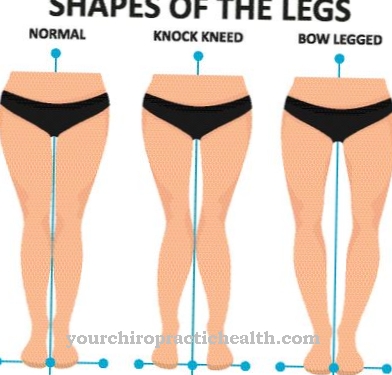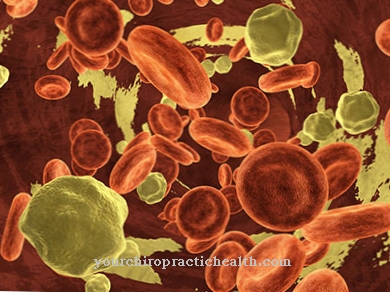The following is a description of what exactly is a Respiratory depression respectively Hypoventilation deals with what causes it and what symptoms can possibly be used to infer it. Furthermore, information is given on the medical diagnosis, the course, and the treatment and prevention of respiratory depression.
What is respiratory depression?

© bilderzwerg - stock.adobe.com
The normal number of breaths for the average adult is about 16 to 20 breaths per minute.
One speaks of respiratory depression when the frequency of the breaths is reduced, i.e. when breathing is slowed down with fewer than ten breaths per minute. However, these do not necessarily contain less volume than is the case with breathing at normal speed, which is why respiratory depression usually does not lead to shortness of breath in the person concerned.
The problem, however, is that the body's gas exchange cannot proceed optimally as a result, which can lead to difficulties in maintaining the human organ functions.
causes
Respiratory depression occurs when the respiratory center does not respond optimally to the respiratory drive, which regulates the carbon dioxide (CO2) and oxygen (O2) levels in the blood.
If, for example, the CO2 content of a person's blood is too high, the number of breaths per minute can be increased with increased respiratory drive in order to reduce the CO2 in the blood by exhaling. If a person suffers from respiratory depression, this gas exchange can no longer take place properly, since breathing is too superficial or too slow. This leads to an increased CO2 partial pressure in the blood and there is a risk of suffocation for the person concerned.
With regard to the causes, a distinction must be made between peripheral and central respiratory depression.
In the case of peripheral respiratory depression, for example, the cause is not the central control in the central nervous system, which is still preserved, but rather the periphery. It can be caused by an overdose of muscle relaxants, various neurological diseases, or an obstruction in the airways.
With central respiratory depression, however, the respiratory center in the brain is no longer fully functional. This occurs, for example, due to certain medications, a craniocerebral trauma, sleep apnea syndrome, increased intracranial pressure, poisoning of the body, for example with alcohol or morphine, or due to a cerebral infarction.
You can find your medication here
➔ Medication for shortness of breath and lung problemsSymptoms, ailments & signs
Respiratory depression manifests itself primarily through slowed breathing. This leads to shortness of breath and shortness of breath in the further course. Ultimately, there are acute symptoms of suffocation and, as a result, a panic attack, which manifests itself in sweats and an increased pulse. Respiratory depression also manifests itself through sleep problems, tiredness and anxiety.
Mental deficiency symptoms as well as confusion and poor concentration can occur. Many people suffer from muscle twitching or cyanosis, a blue discoloration of the skin that is particularly noticeable on the fingers and the mucous membranes in the mouth. Furthermore, respiratory depression can cause psychological problems.
For example, depression and anxiety disorders are sometimes related to a chronic lack of oxygen in the brain. As the disease progresses, the symptoms mentioned increase in intensity and usually lead to further complaints. Externally, respiratory depression can be recognized primarily by the cyanosis mentioned and the characteristic muscle twitching.
But it can also lead to paleness and changes in the size of the pupils. Finally, respiratory depression manifests itself as a respiratory arrest, which, if left untreated, leads to death. Respiratory depression as a result of morphine poisoning can make itself felt, for example, through nausea and vomiting, fatigue and a number of other symptoms.
Diagnosis & course
Possible symptoms that can be caused by respiratory depression include shortness of breath, sleep problems, weakness, anxiety, confusion, delirium, fatigue, seizures, muscle twitching or cyanosis in the sick person. However, these possible symptoms by no means allow a clear diagnosis of respiratory depression, which can only be diagnosed by a blood gas analysis carried out by a doctor.
The exact degree of respiratory depression can also be determined here, to what extent it is hazardous to the patient's health and what measures must be taken. The course differs depending on the degree of respiratory depression. In the case of pronounced respiratory depression, after the steady increase in the CO2 content in the blood and severe breathing problems, breathing may finally stop if no adequate measures are taken to counteract these reactions.
Complications
Respiratory depression can cause a number of complications. First of all, the reduced breathing rate leads to fatigue, muscle twitching or confusion; Symptoms that can later lead to seizures, delirium and anxiety disorders. If left untreated, respiratory depression also leads to shortness of breath, which becomes worse over time and can ultimately lead to respiratory failure.
If no acute treatment is given by then at the latest, circulatory collapse will result, resulting in a coma and death of the person concerned. Respiratory depression as a result of morphine poisoning is accompanied by other complaints such as nausea and vomiting as well as fatigue. In the treatment of respiratory depression, complications can arise if artificial ventilation is necessary; then there is a risk of sore throats, coughs, chronic infectious diseases or pneumonia.
Hemoptysis, bloody sputum as a result of a severe infection, can also occur rarely. Certain medications can also increase respiratory depression and subsequently cause sleep apnea, increased intracranial pressure or even a cerebral infarction. Early treatment of the disease is the most effective remedy for the severe course and possible complications of respiratory depression.
When should you go to the doctor?
Ideally, respiratory depression is prevented through regular check-ups and comprehensive medical treatment. High-risk patients (patients with nerve injuries, trauma or neurological diseases) should clarify the possible consequences and risks of the underlying disease. The same applies to people who regularly take opioids, barbiturates or sedatives. By clarifying the dangers, it is possible to react quickly and comprehensively in the event of respiratory depression.
If an acute respiratory depression occurs, the emergency doctor must be alerted immediately. Various warning signs can be used to determine whether it is hyperventilation. Most often the symptom is associated with decreased breathing movement, blue lips or fingers, and fatigue. In the further course there is circulatory weakness and finally respiratory arrest.
If one or more of these signs can be observed, the person concerned must be treated immediately. Until the rescue service arrives, first aid measures and possibly also resuscitation measures must be carried out. In addition, if possible, the cause of the respiratory depression should be determined in order to enable rapid treatment.
Doctors & therapists in your area
Treatment & Therapy
When treating respiratory depression, the trigger is primarily aimed at, as this is the only way to completely counteract respiratory depression.
If a patient is diagnosed with respiratory depression due to poisoning with morphine, then in addition to therapy for morphine poisoning with the morphine antagonist naloxone and gastric lavage, the symptoms of respiratory depression are also counteracted, for example by intubation and mechanical ventilation or cardiac massage of the person concerned.
The type of treatment still depends on the degree of respiratory depression. If the sick person suffers from serious breathing problems and the heart and brain are no longer adequately supplied with oxygen, this may have to be ventilated before the actual causes that lead to these complaints can be dealt with.
Outlook & forecast
Respiratory depression can lead to a life-threatening condition without medical treatment. The permanent undersupply of the organism with oxygen triggers shortness of breath, sleep disorders and permanent high blood pressure. Without medical attention, the risk of sudden dysfunction or system failure increases. There is a risk of an acute condition that can lead to lifelong impairments or secondary diseases.
In severe cases, multiple organ failure sets in, which is fatal. With the permanent overload of the heart muscle with high blood pressure, the risk of heart failure increases. The patient is threatened with significant health disorders or a fatal course of the disease for the rest of his life.
With medical care for the patient, the chances of recovery increase immensely. If you have mild respiratory depression, there is a good chance that you will be free of symptoms. Learning breathing techniques or managing healthy breathing in different situations can provide permanent relief. The more severe the disease, the greater the likelihood that continued medical care will be necessary in order not to experience deterioration in health.
If there is pronounced respiratory depression, the chances of recovery decrease significantly. If there is no possibility that the CO² level in the blood will rise permanently, considerable irregularities will occur. These can lead to unexpected respiratory arrest and thus to the death of the patient.
You can find your medication here
➔ Medication for shortness of breath and lung problemsprevention
To prevent respiratory depression, the same applies: Since respiratory depression is not a disease of its own but is triggered by other malfunctions in the body, the only possible preventive measure is to avoid it if possible.
Aftercare
Mild respiratory depression offers a good chance of a complete cure. If this succeeds, you can do without follow-up care. A recurrence is not expected for the time being. However, that does not mean that there is immunity. The patient may again suffer from the same or different causes that trigger respiratory depression.
The situation is different if the causes of respiratory depression are not cured causally. Then the typical complaints arise. Respiratory depression that leads to death can occur at any time. It is important to prevent complications and to realize a symptom-free everyday life. The attending physician usually orders imaging procedures as part of the follow-up care.
The CT and MRI in particular provide clarity about muscle and nerve damage. Depending on the intensity of the underlying disease, the doctor will determine whether an outpatient or inpatient surveillance should be used. In many cases, drug therapy is sufficient. For example, naloxone works as an antidote when the respiratory depression is triggered by opioids. In other cases, breathing training helps.
The patient learns how to ensure a sufficient number of deep breaths. In acute, life-threatening situations, artificial ventilation is inevitable. This prevents a lack of oxygen in the brain. People who experience decreased breathing must call an emergency doctor.
You can do that yourself
Respiratory depression can typically be recognized by a decreased breathing rate of less than ten breaths per minute. There is then a general lack of oxygen supply to the body. This can cause symptoms such as confusion, seizures, muscle twitching and the externally visible blue discoloration of the skin (cyanosis). Respiratory depression can have many different causes, so that adjustments in everyday life and possible self-help measures must be based on it.
If a person suffers from acute respiratory depression, quick action is required, so it is advisable to alert an emergency doctor, as life-threatening respiratory failure can occur. In cases in which persistent drug abuse or intoxication leads to impaired breathing, an initial self-help measure can be, for example, deliberately induced vomiting.
The most common reason for pauses in breathing are nightly sleep apnea attacks, which are caused by the trachea being blocked by the uvula on the soft palate. The most important self-help is then to take suitable measures such as wearing a CPAC mask that works with a slight overpressure to prevent the trachea from being obstructed.
Respiratory depression can either be controlled centrally via the respiratory center or be caused by local organic problems. Adaptation to everyday life and self-help is often not possible in such cases. Artificial ventilation - temporarily or permanently - may even be necessary as an emergency measure.













.jpg)

.jpg)
.jpg)











.jpg)